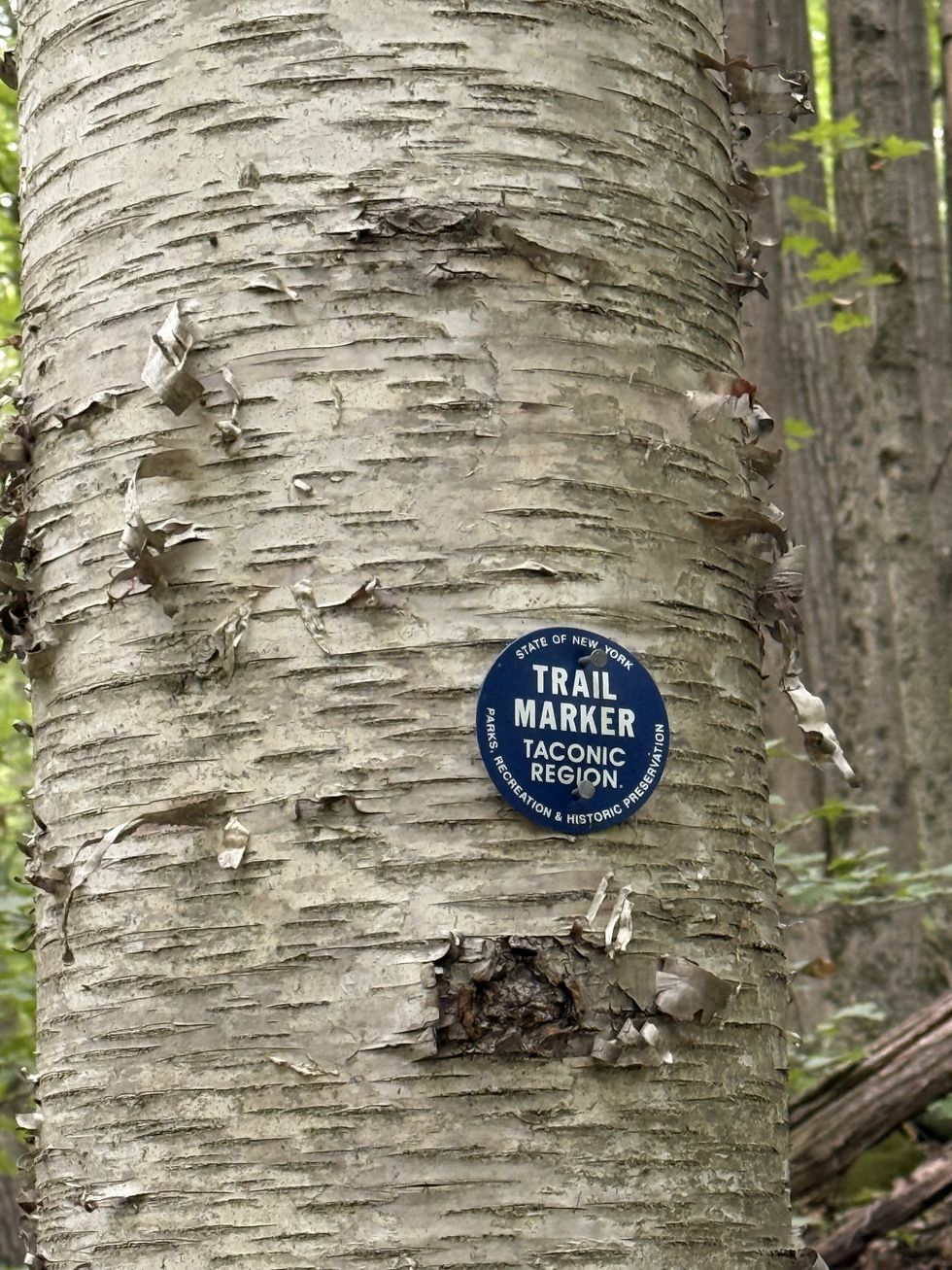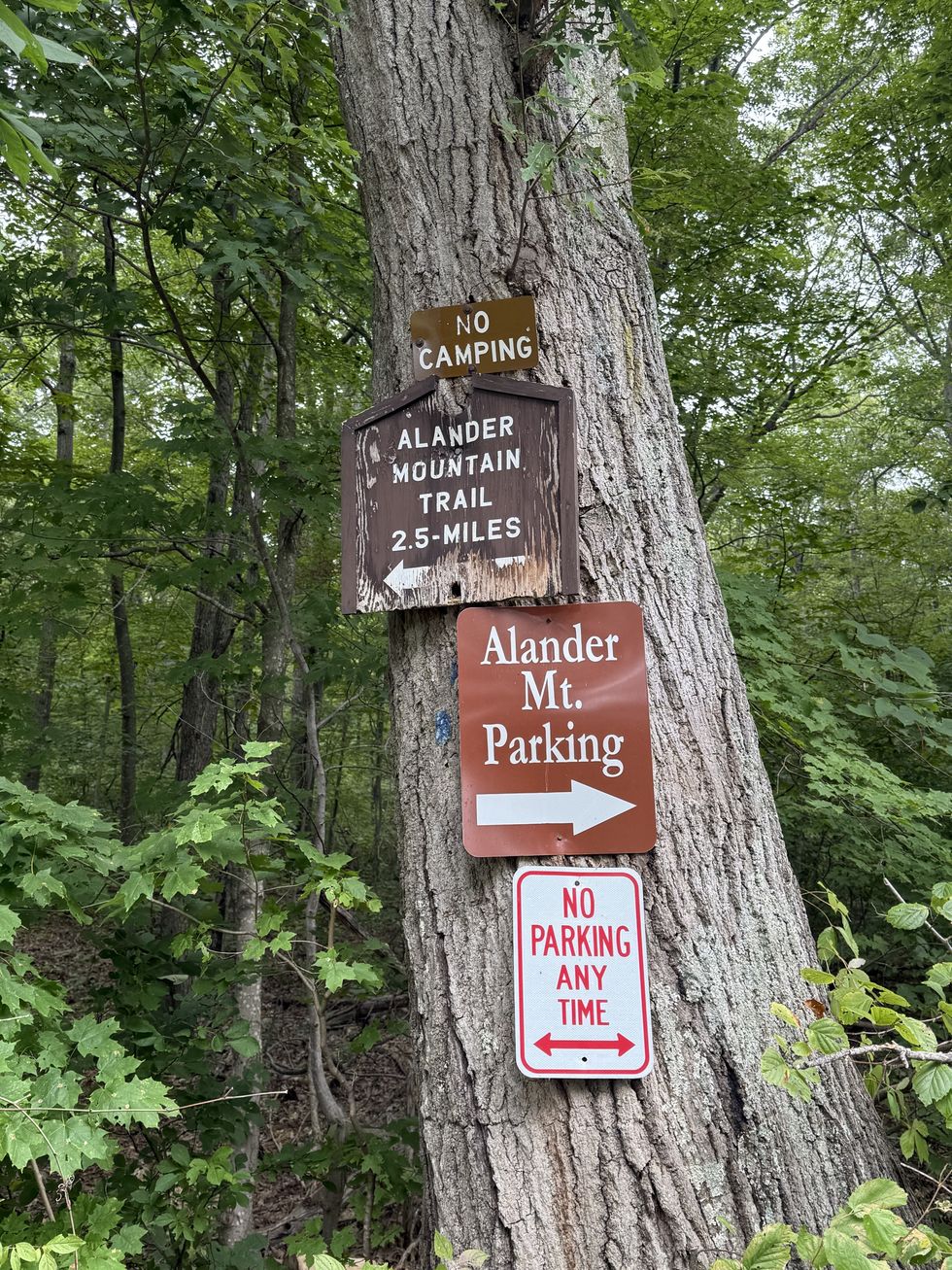Hiker’s Notebook — Hitting the Alander Brooke Trail

Distant ridges occasionally peak through the dense tree cover on the Alander Mountain Trail, providing a view of the rugged Oblong Valley landscape.
Photo by Grace Demarco

Distant ridges occasionally peak through the dense tree cover on the Alander Mountain Trail, providing a view of the rugged Oblong Valley landscape.
MILLERTON — On a warm Sunday, I ventured to escape the heat of a mid-August afternoon under the bright-green protective canopy of the Alander Brooke and CCC Trail. After the minor delay of forgetting my boots at home, I laced up my well-loved Merrells and took to the trail for the perfect mind-clearing and balancing activity to bridge one week to another.
This 2.6 mile hike is accessible from Under Mountain Road in Millerton, just off of Route 22. I headed down the road, passing the trailhead marked by visible signs on the left, and followed the arrows up a bit toward a parking pulloff.
After parking and retracing my steps a short way down the road, I headed down the Alander Mountain trail. Immediately I was under the full coverage of the trees above, engulfed by the sights and sounds of nature.
Although there were no other hikers to be found on this late afternoon, the wide trail appeared to be heavily trafficked and well marked. The compact and colorful fallen leaves, scattered pinecones and acorns set the trail aside from its fern and vegetation linings.
Shortly after beginning, I approached a fork in the trail and, following the signs, went left toward the easier Alander Mountain trail. As I winded through the trail with manageable inclines and declines, I followed the blue trail markers which appeared frequently on the trees.

Although my heart beat rapidly and I was getting a workout, my mind and body calmed the second I stepped off of the concrete and onto the trail. The sights and sounds around me captured my attention and I absorbed everything I could in the 2.6 miles that separated me from the edge of the woods and the resumption of real life responsibilities.
The trail remained non-technical and beginner friendly with easy footing, allowing me to keep my head and eyes up. Along with the marginal wood ferns, the trail was lined with common witch hazel, white birch and the occasional white baneberry. I was greeted by chipmunks and squirrels who scurried across the trail ahead of me, and the birds, visible and hidden, accompanied my trek with their songs.
Along with the melodious and regular crunch coming from under my boots, the flow of an upcoming body of water bubbled through the brush. The trickling water added to the already present harmonies of nature all around me. Shortly after, at about 0.6 miles, I approached a culvert and crossed over a small stream toward another split in the trail.
At the fork, the blue trail veers to the right and straight up Alander Mountain, but bare left for the CCC loop which remains manageable and beginner friendly. Although the loop was unmarked, the trail was unmistakable.
It seemed to be the road less traveled, in the best way possible, as the trail thinned and wound toward a shaded downhill stretch. Here, I was even more a part of my surroundings. The trees provided refuge from the sun which peaked through the gaps in leaves, offering a welcoming and cooling breeze. A black and white striped feather had dropped from its original wearer and was now, like the leaves, a part of the trail.
As I approached the tip of the CCC loop, marking the halfway point of my adventure, I curved through a grassy area and was met by a frog who hopped across into the shelter of the nearby foliage. I heard the frog longer than I saw him, as the leaves rustled with its every movement.

After walking around a white birch road block, two stone walls corralled the trail until the loop circled back and met up with the blue trail.
The scent of pine and something sweet lingered in the air when I stopped for a moment after hearing rustling in the grass. From out of the brush, turkeys, one after the other, emerged just feet ahead from my right. Some ran, some flew, but no less than twenty turkeys flapped their wings and waved me goodbye.
After they finished their grand gesture, I stood there and thanked myself for lacing up my boots and walking the trail. To encounter animals and plants in a place we all share is a gift. Taking the time for myself and getting out there was the best thing I could do.
As the warmth of summer lingers and gives way to fall, it is the perfect time to grab your old and dusty boots from the attic and get back out there. It is also the perfect time to step out onto the trail for the first time. Let the breeze push you toward the everchanging landscape of the forest, especially through the changing of the seasons. The trails will always be there for you.
Alander Brook and CCC Trail is not the only trail in the area. For a moderate 5-mile trail look to Mount Frizzell and Brace Mountain Loop Trail. For a short, yet steep, trail with waterfalls, look to the Quarry Hill Trail. For an easy 2.4 mile hike, look at the Mary Moore Cliff Trail Loop.
For more information on hikes nearby, complete with maps, reviews, and difficulty ratings, alltrails.com is a great and free resource.
Whether it’s short, long, fast, slow, completely flat or a vertical climb, the trees will overshadow your worries, and the breeze will carry you along. The hardest part is getting there.
After that, it’s just a walk in the woods.
The Stone Round Barn at Hancock Shaker Village.
My husband Tom, our friend Jim Jasper and I spent the day at Hancock Shaker Village in Pittsfield, Massachusetts. A cold, blustery wind shook the limbs of an ancient apple tree still clinging to golden fruit. Spitting sleet drove us inside for warmth, and the lusty smells of manure from the goats, sheep, pigs and chickens in the Stone Round Barn filled our senses. We traveled back in time down sparse hallways lined with endless peg racks. The winter light was slightly crooked through the panes of old glass. The quiet life of the Shakers is preserved simply.

Originally founded in England, the Shakers brought their communal religious society to the New World 250 years ago. They sought the perfection of heaven on earth through their values of equality and pacifism. They followed strict protocols of behavior and belief. They were celibate and never married, yet they loved singing and ecstatic dancing, or “shaking,” and often adopted orphans. To achieve their millennialist goal of transcendental rapture, we learned, even their bedclothes had to conform: One must sleep in a bed painted deep green with blue and white coverings.
Shakers believed in gender and racial equality and anointed their visionary founding leader, Mother Ann Lee, an illiterate yet wise woman, as the Second Coming. They embraced sustainability and created practical designs of great utility and beauty, such as the mail-order seed packet, the wood stove, the circular saw, the metal pen, the flat broom and wooden clothespins.
Burning coal smelled acrid as the blacksmith fired up his stove to heat the metal rod he was transforming into a hook. Hammer on anvil is an ancient sound. My husband has blacksmithing skills and once made the strap hinges and thumb latches for a friend’s home.
Shaker chairs and rockers are still made today in the woodworker’s shop. They are well made and functional, with woven cloth or rush seats. In the communal living space, or Brick Dwelling, chairs hang from the Shaker pegs that run the length of the hallways, which once housed more than 100 Shakers.

In 1826, the 95-foot Round Stone Barn was built of limestone quarried from the land of the 3,000-acre Hancock Shaker Village. Its unique design allowed a continuous workflow. Fifty cows could stand in a circle facing one another and be fed more easily. Manure could be shoveled into a pit below and removed by wagon and there was more light and better ventilation.
Shakers called us the “people of the world” and referred to their farm as the City of Peace. We take lessons away with us, yearning somehow for their simplicity and close relationship to nature. One Shaker said, “There’s as much reverence in pulling an onion as there is in singing hallelujah.”
A sense of calm came over me as I looked across the fields to the hills in the distance. A woman like me once stood between these long rows of herbs — summer savory, sage, sweet marjoram and thyme — leaned on her shovel brushing her hair back from her eyes, watching gray snow clouds roll down the Berkshires.
More information at hancockshakervillage.org

Exterior of Lakeville Books & Stationery in Great Barrington.
Fresh off the successful opening of Lakeville Books & Stationery in April 2025, Lakeville residents Darryl and Anne Peck have expanded their business by opening their second store in the former Bookloft space at 63 State St. (Route 7) in Great Barrington.
“We have been part of the community since 1990,” said Darryl Peck. “The addition of Great Barrington, a town I have been visiting since I was a kid, is special. And obviously we are thrilled to ensure that Great Barrington once again has a new bookstore.”
The second Lakeville Books & Stationery is slightly larger than the first store. It offers more than 10,000 books and follows the same model: a general-interest store with a curated mix of current bestsellers, children’s and young readers’ sections; and robust collections for adults ranging from arts and architecture, cooking and gardening, and home design to literature and memoirs. Anne reads more than 150 new titles every year (as many as a Booker Prize judge) and is a great resource to help customers find the perfect pick.
A real-time inventory system helps the store track what’s on hand, and staff can order items that aren’t currently available. There is also a selection of writing and paper goods, including notecards, journals, pens and notebooks, as well as art supplies, board games, jigsaw puzzles and more. The owners scour the stationery trade shows twice a year and, Darryl says, “like to tailor what we offer to suit the interest of our customers in each market.”
The Pecks know what it takes to run a successful local enterprise. Darryl has a 53-year background in retail and has launched several successful businesses. He and Anne owned and operated a bookstore on St. Simons Island, Georgia, from 2019 to 2025. They are tapping into their local roots with both stores. They raised their family in Sharon, and their daughter Alice, a native of the Northwest Corner, manages the Lakeville store.

The family values the role that a retail store plays as a supporting partner in the community, and they prioritize great management in both locations, hiring and training talent from local communities. Their 10 team members across both stores are from the area, and two of the Great Barrington employees previously worked at Bookloft.
Darryl and Anne’s attention to customer service is everywhere apparent and adds to the enjoyable and irreplaceable in-store shopping experience. The books are in pristine condition, eliminating the risk of damage that sometimes occurs during shipping. This is especially important for books that will live on people’s shelves and coffee tables for years.
Darryl says, “People love the in-store discovery — you find books you didn’t know existed, which is very difficult to do on a website. Also, many customers depend on our recommendations when visiting. There is a saying about bookstores versus online ordering: We may not have exactly what you were looking for, but we have what you want.”
Lakeville Books & Stationery’s Great Barrington store is open 7 days a week, Monday-Saturday, 10 a.m. to 6 p.m., and Sunday, 11 a.m. to 5 p.m. Parking is available in the lot behind the building and in the parking lot behind the firehouse. The entrance to the store is accessible from the store parking lot.
For more information, go to lakevillebooks.com., and sign-up for the Lakeville Books newsletter.
Richard Feiner and Annette Stover have worked and taught in the arts, communications, and philanthropy in Berlin, Paris, Tokyo and New York. Passionate supporters of the arts, they live in Salisbury and Greenwich Village.